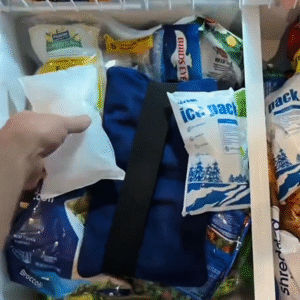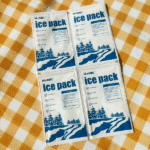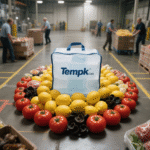Dry Ice Cubes vs Ice Packs – Which Is Better for Cold Chain Shipping?
Shipping temperature-sensitive goods requires reliable cooling solutions. Two commonly used methods are dry ice cubes and ice packs, each offering distinct advantages. This article will dive into the pros and cons of both, helping you choose the best option for your shipping needs.

What Are Dry Ice Cubes and Ice Packs?
Dry Ice Cubes
El hielo seco es la forma sólida de dióxido de carbono (Co₂), which sublimates directly from solid to gas at -78.5°C (-109.3°F). A diferencia del hielo tradicional, dry ice doesn’t leave water behind, making it a preferred choice for shipping frozen goods such as seafood, carne, y productos farmacéuticos. Dry ice cubes are solid blocks or pellets, providing long-lasting cooling power for temperature-sensitive shipments.
Paquetes de hielo
bolsas de hielo, also known as gel packs, are pouches filled with a gel or liquid that freezes to maintain a temperature range typically between 0°C and 10°C (32° F a 50 ° F). They are generally more affordable and safer to handle compared to dry ice, but they do not achieve the ultra-low temperatures that dry ice provides. Ice packs are typically used for products that require refrigeration, no congelado.
Dry Ice Cubes vs Ice Packs: Diferencias clave
| Característica | Dry Ice Cubes | Paquetes de hielo |
|---|---|---|
| Rango de temperatura | Extremely low (-109.3°F / -78.5°C) | Moderado (32° F a 50 ° F / 0°C a 10°C) |
| Sublimation/Melting | Sublimada en gas, sin residuos líquidos | Melts into liquid, potential for water damage |
| Manejo de seguridad | Requires gloves and ventilation | Safe to handle without special precautions |
| Cumplimiento normativo | Subject to shipping regulations | Generally no special regulations |
| Reutilizabilidad | De un solo uso | Reutilizable |
| Costo | Higher due to single-use and handling requirements | Más bajo, especially for reusable types |
When to Use Dry Ice Cubes
Bienes congelados
For items like ice cream, carnes congeladas, y mariscos, dry ice is the ideal solution. It ensures these products remain completely frozen throughout the shipping process, even during long-distance journeys.
Farmacéuticos y biotecnología
Dry ice is essential for transporting vaccines, biológicos, and temperature-sensitive medical supplies. Its ultra-low temperatures prevent the degradation of these valuable products, ensuring they arrive at the destination in optimal condition.
Best Practices for Using Dry Ice
-
Ventilación adecuada: Ensure containers are ventilated to allow CO₂ gas to escape and avoid pressure buildup.
-
Aislamiento adecuado: Use insulating materials to slow the sublimation rate and keep items frozen for as long as possible.
-
Cumplimiento normativo: Be aware of shipping regulations related to dry ice, including labeling and documentation requirements.
When to Use Ice Packs
Chilled Foods
Ice packs are perfect for shipping items like dairy, frutas, y bebidas, which need to stay cool but not frozen. These products benefit from a steady temperature range of around 0°C to 10°C, which ice packs provide effectively.
Suministros médicos
Certain medical supplies, such as some vaccines or lab samples, require refrigeration, Pero no congelando. Ice packs are suitable for maintaining these temperatures during transit.
Short-Term Shipments
For shorter shipments, ice packs are more than sufficient. They provide reliable cooling for up to 24 horas, making them ideal for quick deliveries or local shipments.
How Dry Ice Cubes and Ice Packs Compare in Cold Chain Shipping
Costo
Dry ice is typically more expensive than ice packs due to its superior cooling power and handling requirements. Sin embargo, it provides longer-lasting cooling, which can be more cost-effective for long-distance shipments. Ice packs are cheaper, especially when reused multiple times, but they do not provide the same level of cooling as dry ice.
Duración del enfriamiento
Dry ice can maintain temperatures for up to 72 horas o más, depending on the shipment’s size and insulation. Ice packs typically last between 12 y 24 hours and are best suited for short shipments.
Moisture Concerns
A significant advantage of dry ice is that it does not create water residue as it sublimates, unlike ice packs, which melt into liquid. This makes dry ice an excellent option for preventing moisture damage to sensitive goods, such as electronics or certain medical supplies.
Practical Tips for Choosing the Right Cooling Method
-
Assess Product Sensitivity: If your product needs to stay frozen, dry ice is the best choice. For refrigerated items, ice packs are sufficient.
-
Duración del envío: Para largos envíos, dry ice will maintain ultra-low temperatures for several days. For short-term deliveries, ice packs are more economical and efficient.
-
Compliance and Safety: Ensure you follow all necessary regulations for dry ice shipments, including proper labeling and packaging. Ice packs have fewer restrictions and are easier to handle.
Estudios de caso
Seafood Company Shipping to Remote Locations
A seafood company replaced gel packs with dry ice ice pack sheets for their remote shipments. The ultra-low temperature kept the fish frozen for 72 horas, reducing spoilage and saving $15 per shipment. They reused the dry ice sheets three times, resulting in long-term cost savings and waste reduction.
Medical Supply Company Shipping Vaccines
A medical supply company utilized dry ice for their vaccine shipments, maintaining temperatures well below freezing. The product arrived safely, adhering to all regulatory standards, and ensuring the integrity of the vaccines.
2025 Tendencias en la logística de la cadena de frío
A medida que nos acercamos 2025, there are several trends shaping the future of cold chain logistics, including innovations in dry ice use and the adoption of more sustainable practices.
Latest Innovations Overview
-
Paquetes de hielo secos reutilizables: These packs are gaining popularity due to their eco-friendly design and ability to be reused multiple times.
-
Sensores IoT: Smart sensors will provide real-time tracking of temperature-sensitive shipments, improving efficiency and reducing spoilage.
-
Vacuum Insulation: New insulation technologies will enhance the performance of dry ice by minimizing heat exchange during transit.
Preguntas frecuentes (Preguntas frecuentes)
Q1: ¿Cuánto dura el hielo seco en un envío??
El hielo seco generalmente dura entre 24-72 horas, dependiendo de la cantidad utilizada, el aislamiento, and the shipment duration.
Q2: Can I use dry ice for food shipments?
Sí, dry ice is perfect for shipping frozen foods like seafood and ice cream. Sin embargo, be cautious when shipping fresh produce, as dry ice may freeze them and alter their texture.
Q3: How much dry ice should I use for a shipment?
Una pauta general es utilizar 5-10 lbs of dry ice per day of shipment. Adjust based on the product type and insulation quality.
Conclusión y próximos pasos
Dry ice cubes and ice packs each have unique benefits depending on your shipping needs. Dry ice offers longer-lasting cooling for frozen goods and pharmaceuticals, while ice packs are cost-effective and ideal for short shipments and refrigerated items. By choosing the right cooling solution, you can ensure the integrity of your temperature-sensitive products during transit.
Siguientes pasos:
Consult with Tempk to integrate dry ice solutions into your shipping strategy. Our experts will help you select the right combination of products and packaging to meet your specific needs.
Acerca de Tempk
Tempk specializes in providing cutting-edge cold chain logistics solutions. We offer a range of products, including dry ice cubes, bolsas de hielo, and advanced temperature monitoring systems, tailored to the needs of the food, farmacéutico, e industrias biotecnológicas. Let us help you improve your cold chain logistics and ensure your products arrive safely, No importa la distancia.























